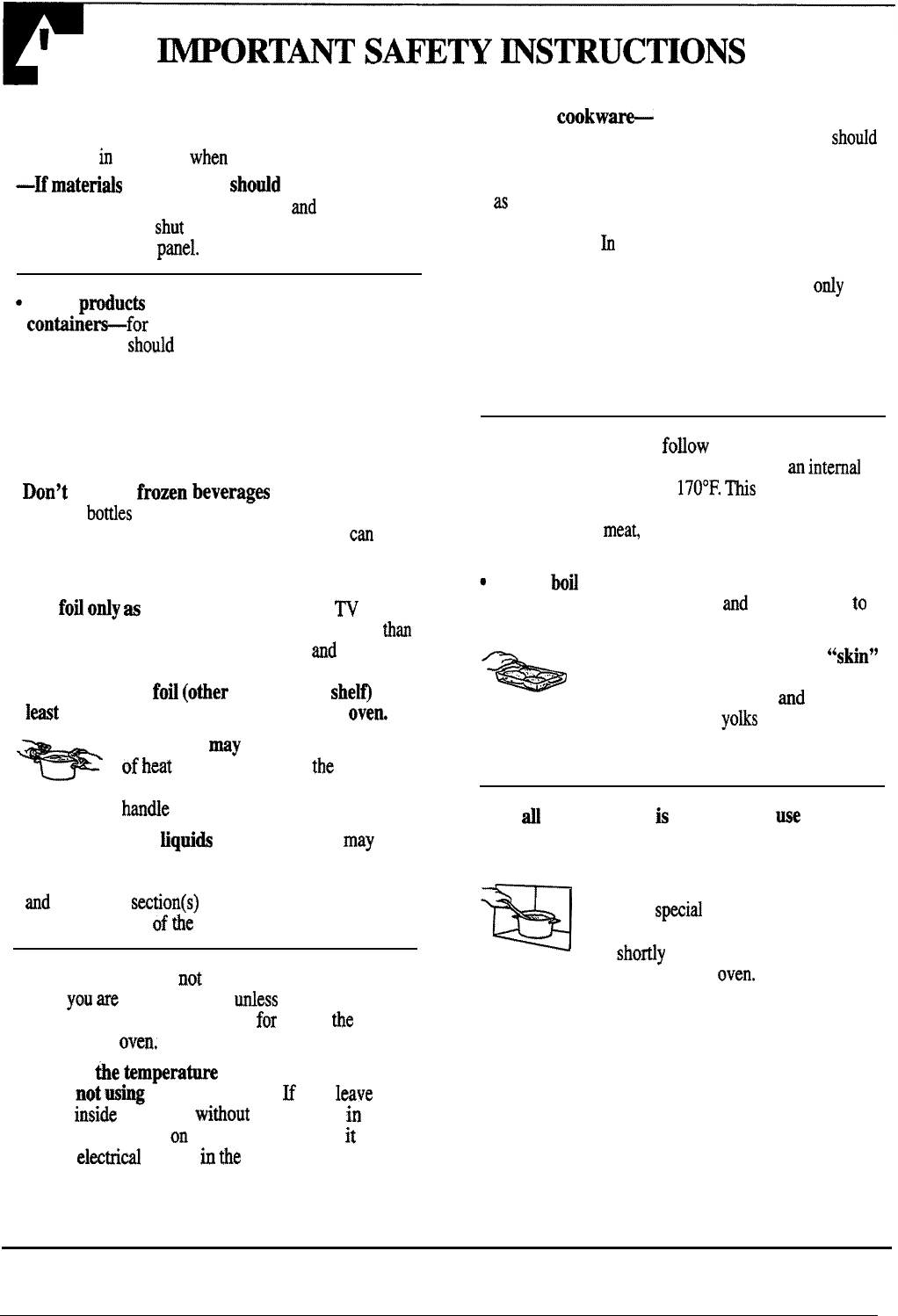
J
I
●
WORTANT
SAmW
~STRUC~ONS
(continued)
—Do not use the oven for storage purposes.
Do not leave paper products, cooking utensils
or food
in
the oven
when
not in use.
—Ematerids
inside oven
shotid
ignite,
keep
oven door closed, turn oven off,
and
disconnect
power cord, or
shut
off power at the fuse or
circuit breaker
panel.
*
Some
produc~
such as whole eggs and sealed
containe-for
example, closed jars-will
explode and
should
not be heated in this
microwave overt. Such use of the microwave
oven could result in injury,
●
Avoid heating baby food in glass jars, even
without their lids; especially meat and egg
mixtures.
●
Don’t
defrost
frown
beveragw
in narrow
necked
boties
(especially carbonated beverages).
Even if the container is opened, pressure
cau
build
up, This can cause the container to burst, possibly
resulting in injury,
●
Use
fofl
ody
as
directed in this book,
W
dinners may be microwaved in foil trays less
than
3/4” high; remove the top foil cover
and
return the
tray to the box. When using foil in the microwave
oven,
keep the
fofl
(other
than metal
shel~
at
least
1 inch away from the sides of the
ovem
-
●
Cookware
may
become hot
because
of
beat
transferred from
the
heated
food. Pot holders may be needed to
hande
the cookware,
●
Foods cooked in
hquids
(such as pasta)
may
tend
to boil over more rapidly than foods containing
less moisture. Should this occur, refer to the Care
and
Cleaning
section(s)
for instructions on how to
clean the inside
of
the
oven.
●
Thermometer-Do
not
use a thermometer in
food
you
are
microwaving
urdess
the thermometer
is designed or recommended
for
use in
the
microwave
oven,
●
Remove
he
timperati
probe from the oven
when
not
wing
it to cook with.
E
you
Ieave
the
probe
inside
the oven
without
inserting it
in
food
or liquid, and turn
on
microwave energy,
it
can
create
electrid
arcing
in
the
oven and damage
oven walls.
4
Plastic cookware designed
●
Plastic
cookw~
for microwave cooking is very useful, but
shodd
be used carefully. Even microwave-safe plastic
may not be as tolerant of overcooking conditions
as
are glass or ceramic materials and may
soften or char if subjected to short periods of
overcooking.
h
longer exposures to overcooking,
the food and cookware could ignite. For these
reasons: 1) Use microwave-safe plastics
ody
and
use them in strict compliance with the cookware
manufacturer’s recommendations. 2) Do not
subject empty cookware to microwaving.
3) Do not permit children to use plastic
cookware without complete supervision.
●
When cooking pork,
fo~ow
the directions
exactly and always cook the meat to
an
intemd
temperature of at least
170°F.
~s
assures that,
in the remote possibility that trichina maybe
present in the
mea~
it will be killed and meat
will be safe to eat.
*
Do
not
bofl
eggs in a microwave oven.
Pressure
will build up inside egg yolk
aud
will cause it
to
burst, possibly resulting in injury.
-
●
Foods with unbroken outer
“skin”
such as potatoes, sausages, tomatoes,
apples, chicken livers
and
other
giblets, and egg
yoks
(see previous
caution) should be pierced to allow
steam to escape during cooking.
●
Not
dl
plastic wrap
is
suitable for
w
in
microwave ovens.
Check the package for
proper use.
●
Spontaneous boiling-Under
certain
specitd
circumstances,
liquids may start to boil during
or
shotiy
after removal from
the microwave
oven.
To prevent
burns from splashing liquid, stir the
liquid briefly before removing the
container from the microwave oven.


















